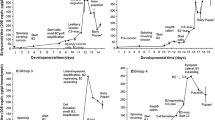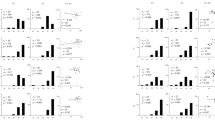Abstract
Puparium formation in Drosophila lebanonensis casteeli is obviously restricted to a certain phase in circadian oscillation. The question whether or not the release of molting hormone is the actual process which is controlled by the circadian oscillation could be approached by using molting hormone-specific changes in genome activity as indication for changes in hormone titer. The identification of hormone specific changes in the puffing pattern of polytene chromosomes should provide a basis for this study.—To this end, a chromosome map of the 7 polytene chromosome arms (1 acrocentric and 3 metacentric chromosomes) of the species was made. Changes in the puffing pattern associated with puparium formation are described and compared with those occurring in response to experimental administration of β-ecdysone.—89 puffs were regularly observed in midthird instar larvae. Prior to puparium formation 5 new puffs arise, one at an early stage and 4 attaining their maximum size immediately before puparium formation. Concomitantly, 5 puffs increase considerably in size. These changes in the puffing pattern can be reproduced by injection of ecdysone.—Upon injection of the hormone a clear differentiation between fast reacting loci (within 30–60 min) and slow reacting loci (after 3–4 hours) can be found. As in other Drosophila species the immediate response (within 30–60 min) comprises more than one (5) locus.
Similar content being viewed by others
References
Ashburner, M.: Patterns of puffing activity in the salivary glands of Drosophila. I. Autosomal puffing patterns in a laboratory stock of Drosophila melanogaster. Chromosoma (Berl.) 21, 398–428 (1967).
Becker, H. J.: Die Puffs der Speicheldrüsenchromosomen von Drosophila melanogaster. II. Mitt. Die Auslösung der Puffbildung, ihre Spezifität und ihre Beziehung zur Funktion der Ringdrüse. Chromosoma (Berl.) 13, 341–384 (1962).
Berendes, H. D.: Salivary gland function and chromosomal puffing patterns in Drosophila hydei. Chromosoma (Berl.) 17, 35–77 (1965).
— The hormone ecdysone as effector of specific changes in the pattern of gene activities of Drosophila hydei. Chromosoma (Berl.) 22, 274–293 (1967).
Bodenstein, D.: Factors influencing growth and metamorphosis of the salivary glands in Drosophila. Biol. Bull. 84, 13–33 (1943).
Clever, U.: Regulation of chromosome function. Ann. Rev. Genet. 2, 11–30 (1968).
— Karlson, P.: Induktion von Puff Veränderungen in den Speicheldrüsenchromosomen von Chironomus tentans durch Ecdyson. Exp. Cell Res. 20, 623–627 (1960).
Leenders, H. J., Wullems, G. J., Berendes, H. D.: Competitive interaction of adenosine 3′,5′-monophosphate on gene activation by ecdysterone. Exp. Cell Res. 63, 159–164 (1970).
Panitz, R.: Innersekretorische Wirkung auf Strukturmodifikationen der Speicheldrüsenchromosomen von Acricotopus lucidus (Chironomide). Naturwissenschaften 47, 383 (1960).
Pipkin, S. B.: Taxonomic relationships within the Drosophila victoria species group, subgenus Pholadoris. Proc. ent. Soc. Wash. 63, 145–161 (1961).
Pittendrigh, C. S., Scopic, S. D.: Circadian systems, V. The driving oscillation and the temporal sequence of development. Proc. nat. Acad. Sci. (Wash.) 65, 500–507 (1970).
Poels, C. L. M.: Time sequence in the expression of various developmental characters induced by ecdysterone in Drosophila hydei. Develop. Biol. 23, 210–225 (1970).
Rensing, L., Hardeland, R.: Zur Wirkung der circadianen Rhythmik auf die Entwicklung von Drosophila. J. Insect Physiol. 13, 1547–1568 (1967).
Vogt, M.: Zur Produktion und Bedeutung metamorphosefördernder Hormone während der Larvenentwicklung von Drosophila. Biol. Zbl. 63, 395–446 (1943).
Ward, C. L.: Karvotype variation in Drosophila. Univ. Texas Publ. 4920, 70–79 (1949).
Wharton, L. T.: Analysis of the metaphase and salivary chromosome morphology within the genus Drosophila. Univ. Texas Publ. 4313, 282–319 (1943).
Wheeler, M. R.: The subgenus Pholadoris (Drosophila) with descriptions of two new species. Univ. Texas Publ. 4920, 143–156 (1949).
Author information
Authors and Affiliations
Additional information
In memory of Professor Dr. J. Schultz.
Rights and permissions
About this article
Cite this article
Berendes, H.D., Thijssen, W.T.M. Developmental changes in genome activity in Drosophila lebanonensis casteeli pipkin. Chromosoma 33, 345–360 (1971). https://doi.org/10.1007/BF00284949
Received:
Issue Date:
DOI: https://doi.org/10.1007/BF00284949




